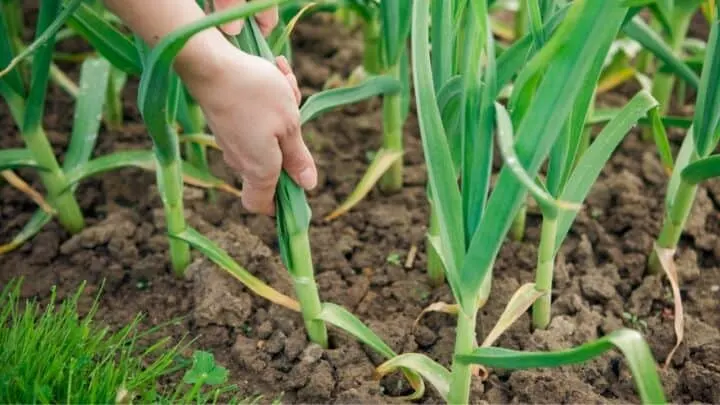Garlic is a universal and amenable crop, which can grow with just about anything, can’t it?
Don’t kid yourselves, though. Garlic isn’t always the best neighbor to have in your veggie patch.
Table of Contents
What to Plant After Garlic
Since garlic prefers a cold growth season, summer crops, such as carrots and spinach, will grow after it. You can also plant aubergines and peppers after it. Carrots, tomatoes, and potatoes can also be planted after garlic as it acts as a natural pest-repellant to these crops.
Why it’s Necessary to Rotate Garlic
Garlic is like any plant: it uses particular nutrients, specifically potash, potassium, and nitrogen.
After a season, it’s useful to rotate garlic out of a cycle, so that the soil can recover, as a number of plants rely on nitrogen for growth.
However, garlic only uses a medium amount of nitrogen, which means it is possible to rotate it with a heavy growth crop, such as tomatoes.
Because it is a ‘light feeder’, garlic doesn’t rely on a large amount of each nutrient. This means that the soil will be relatively healthy after one season, but it should still be rotated with another crop.
This can be one that takes more nutrients from the soil.
Another reason to rotate garlic is that it can attract particular diseases and bugs into the soil, which can be bad for other plants, so it may be advisable to rotate it only every three or four years or so, in the same bed.
Plants that are not susceptible to these bugs or diseases can be successfully rotated with garlic. These include potatoes and carrots.
However, plants such as legumes are affected by the diseases, and cannot be grown after garlic.
If you want to have an ongoing garlic crop, then divide a particular space into different sections. You can grow the garlic in a different section each year.
Companion Growing
Another alternative that you have is to grow another crop alongside garlic, as a companion crop. This will benefit the other plants, because garlic acts as a natural barrier, discouraging pests that may attack them.
Good companion crops for garlic include tomatoes, carrots, and spinach, which are protected by the natural pest-repellant quality.
There are some plants that can even be planted with garlic, including tomatoes, peppers, and carrots.
What to Avoid Growing With or After Garlic
Most legumes, specifically beans, and peas cannot be planted alongside garlic. Asparagus is another plant to be avoided.
This is because the diseases that garlic can attract stunt the growth of these plants. I also recommend that you don’t plant these crops after garlic, as the diseases may remain in the soil.
Another reason why you should avoid growing asparagus with garlic is that they compete for the same nutrients. Asparagus will suffer most, as it is a weaker plant than garlic.
Lettuce is another plant that should not be planted after garlic, which produces chemicals that cause the lettuce to wilt while still in the ground.
Climate
Something you need to consider when you choose what crops to plant is the climate where you live and what time of year you plant the crops.
Garlic prefers cooler temperatures (32°-50° F / 0°-10° C) for germination. This makes it a good winter crop in more temperate climates.
However, if the temperatures in your area get below freezing (32°/ 0° C) in winter, then you will have to plant it in late winter or early spring.
If you use garlic as a winter crop in warmer areas, you could rotate it with tomatoes, carrots and spinach, which are summer crops and should be planted in early spring.
Crop Rotation and What it is
Plants take their nutrients from the soil and different plants take out different nutrients.
This means that the soil in a spot where a particular plant grows will become depleted of certain nutrients, while others remain.
If the same crop is planted in the same place continuously, then the soil will eventually become completely depleted of those particular nutrients and that crop can no longer grow there.
This is why it is necessary to ‘rotate’ crops: plant a different crop in the same spot every second or third year. This gives the soil enough time to recover the nutrients necessary to grow each crop.
Frequently Asked Questions about What to Plant After Garlic
Why can’t I plant garlic year after year in the same spot?
All plants take nutrients from the soil. If you plant garlic year after year, then the nutrients that it takes will be lost from the soil, which means it can no longer grow there. You need to rotate crops in one spot so that the nutrients used by one crop can be regenerated while another crop is growing.
If beans and peas replenish nitrogen in the soil, why can I not plant them after garlic?
The diseases that garlic can attract affect legumes, by stunting their growth. Even after harvesting the garlic, the bugs can remain in the soil and can still affect the plants. This means that you shouldn’t grow beans and peas after or with garlic.
Conclusion
Garlic acts as a natural pest-repellant, which makes it a useful companion crop for most vegetables. It is also a light feeder, which means that it does not take large amounts of nutrients out of the soil.
However, garlic also attracts diseases that can affect others plants growth. It’s crucial to factor in this information when you choose what to grow after garlic.

Daniel has been a plant enthusiast for over 20 years. He owns hundreds of houseplants and prepares for the chili growing seasons yearly with great anticipation. His favorite plants are plant species in the Araceae family, such as Monstera, Philodendron, and Anthurium. He also loves gardening and is growing hot peppers, tomatoes, and many more vegetables.


